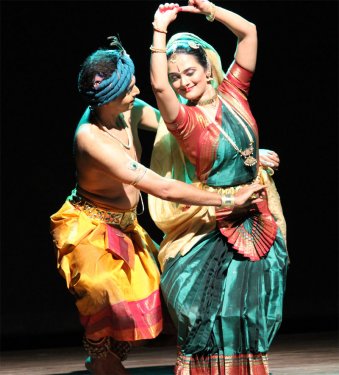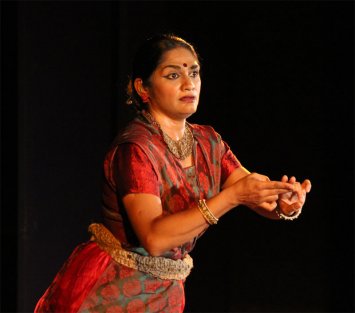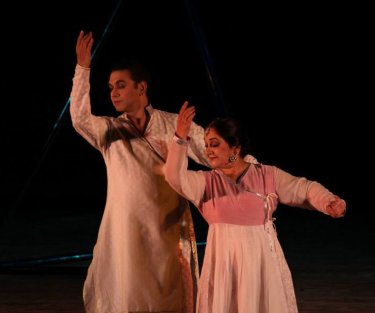
|   |

|   |
Rasadhwani celebrations: Echoes of Universal Harmony - Dr. S.D. Desai e-mail: sureshmrudula@yahoo.co.in May 9, 2014 Rasadhwani, founded by Uma Anantani, began its silver jubilee celebrations on the eve of World Dance Day with Mangalam and dance presentations by worthy disciples of Dr. Kanak Rele under whose exacting guidance Dr. Anantani has acquired her doctorate, of Kumudini Lakhia, who is known to encourage originality and creative imagination among her disciples, and C.V. Chandrasekhar, a distinguished Bharatanatyam exponent who has not given up dancing yet in his late seventies and an excellent teacher.  Vaibhav Arekar  Vaibhav-Shivangee
Photos: Chetan
Chauhan
Young dancers Vaibhav Arekar and Shivangee Vikram, both
brilliantly expressive with the cutting edge classical
training received at Dr. Rele’s Nalanda, gave in their
performance glimpses of the spiritual depth and poetic
luxuriance Kavi Jayadev has created in his all-time
classic Geeta Govindam. The aesthetically
dignified approach here – of the choreographer and the
dancers – retains the essential sensuality the images
invoke and, at the same time, creates tantalizing flashes
of the mystic spirituality that helps an individual soul
feel getting one with the permeating ananda swaroopa
of Krishna that in turn is keen to take it into its fold.We use the two words synonymously, but the fine nuance of connotation the Sanskrit word shringara carries, I am afraid, the English word ‘eroticism’ doesn’t. The erotic desire in Radha’s longing for Krishna gradually creeps in. It is under the influence nature has created with stimulants like the darkness of the night heightened with winds ‘longing to plunge in the snows after weeks of writhing’, cuckoo’s songs and buds on mango trees that Radha’s heart recalls (smarati mano mama) Hari. While the performers’ expressive mudras, mukhabhinaya, padachalana and the body language create an aesthetic detachment in intricate classical style from the sensory imagery that the text lyrically manages, the judiciously sprinkled lokadharmi elements in the extended modern sense and context like a well-modulated initial Bhumika in Gujarati by actor Mahesh Champaklal, Krishna’s cowherd aharya as well as quietly dramatic entries and exits of both the nayak and nayika as also reference to Jayabhikhkhu’s novel in Gujarati based on the poem bring the exceptional work of art across to modern viewers relatively easily. Manjari Chandrasekhar intelligently uses her art and intelligibly presents it to modern audiences. The spiritual tone set by the opening dance performance, remains sustained at the conceptual level in the core segment of her multi-segment solo performance ‘The Earthen Pot’ in Bharatanatyam, set to her guru and father C.V. Chandrasekhar’s evocative music with dominant lower octave drones. It significantly begins with the metaphor of creation on the potter’s wheel analogous with the creation of life, which too has cyclical movement at many levels. Though all segments do not remain anchored by the theme with unbroken continuity, the central one of ‘half-empty-half-full’ Kumbh linked to the struggle for evolution and ‘jal-mein-kumbh kumbh-mein-jal’ mystery treated by poets since antiquity firmly holds the performance.  Manjari Chandrasekhar Photo: Anand Deshpande  Maulik-Ishira Photo: Ravi Tahilramani Maulik and Ishira, who are among only a few of the liveliest and most accomplished dancing couples in the country today – affectionately mentioned in Ahmedabad only by their first names - in two segments from their earlier longer piece Nar-Naari demonstrate their unmatched complementary kinetic creative power. At their exhilarating best, with the basic abstract elements of Kathak like aamad, thaat, paran and fluid footwork in ‘Leela’ to Pt. Vishwamohan Bhatt’s music, they develop a lyrical visible dialogue portraying exciting youthful human moods and emotions like alluring bashfulness, playfulness, romance, and sayujya with their signature twin images. In Aamne-Samane, the nayika individually seems inhibited and uncertain initially emerging behind brittle white short horizontal bars against the stronger, self-assured and assertive nayak standing stubborn behind rather imposing black bars in a pyramid shape. She takes the initiative, even if demurely, slides closer to him and with him grows in confidence – ‘as in life,’ later they say. Two distinctive identities merge leading to a harmonious togetherness. The theme gets pleasingly developed in movement, but modern young women are likely to express a mild dissent at the thought of the nari having to dissolve her identity! Dr. SD Desai, a professor of English, has been a Performing Arts Critic for many years. Among the dance journals he has contributed to are Narthaki, Sruti, Nartanam and Attendance. He guest-edited Attendance 2013 Special Issue. His books have been published by Gujarat Sahitya Academy, Oxford University Press and Rupa. After 30 years with a national English daily, he is now a freelance art writer. |